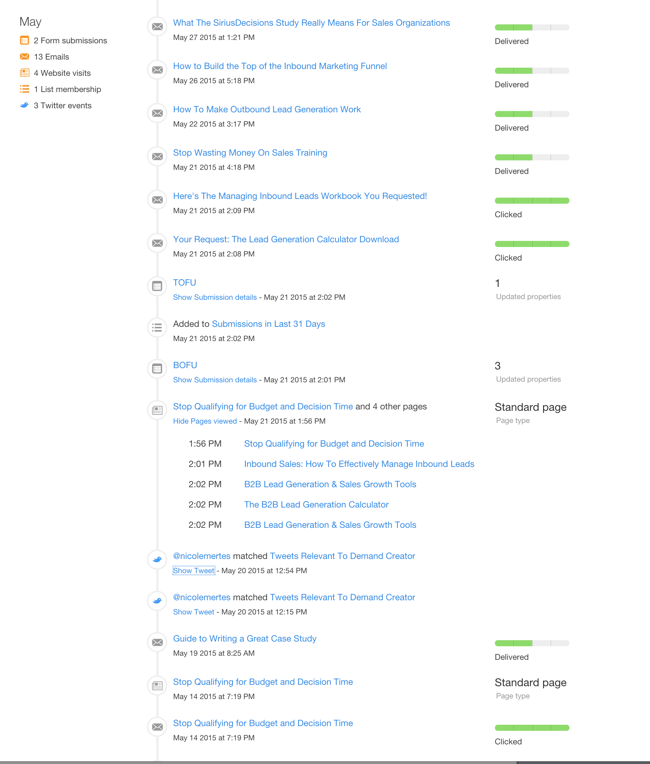 You, or a member of your sales team, have just finished an excellent early stage sales call. On the call, you helped your prospect understand their situation better, you were able to highlight several areas where you could have impact on their situation and you positioned your value proposition well. What do you think your prospect does next?
You, or a member of your sales team, have just finished an excellent early stage sales call. On the call, you helped your prospect understand their situation better, you were able to highlight several areas where you could have impact on their situation and you positioned your value proposition well. What do you think your prospect does next?
Most likely, they’ll visit your website, go to Google to learn even more about the issue and alternatives, talk with their peers and further investigate. But, what happens when they go to your website?
- Does your website present the same message and presence that your sales conversation did?
- Do you have the content that can allow your prospect to engage further, and move themselves through their journey?
- Do you have the content that allows the person you met with to share your value and impact with other role players who speak different languages and have different priorities?
- Do you have the ability to turn anonymous visitors into known visitors, and further to be able to uncover their digital body language?
The Sale That Occurs Online
There’s a growing debate as to how much of the buyer’s journey your prospects actually conduct before talking with a salesperson. What isn’t up for debate is that whether your salespeople are getting in early or not, the prospect is conducting more of the journey on their own (even if it’s parallel to sales conversations taking place).
Additionally, research continues to show that more purchases are moving to a consensus driven approach with multiple influencers within your prospect’s organization directly contributing to the decisions that are made.
This means that, like it or not, more of the sales process and buyer’s journey is occurring online. Your web presence (yes, more than just your website) must take on more responsibility for not only supporting the sales process, but driving the process as well.
I’ve seen more sales lost because of poor website functionality that interferes with the work done by salespeople than I could have imagined. It’s incredibly frustrating to see a B2B sales organization that has invested in salespeople, built great offerings and implemented an effective sales process, yet failed to build their marketing and lead management assets to align with how buyers live and work.
An effective website that is designed to support and drive the sales process has:
- Been built behind clear buyer personas.
- The content is mapped to each persona and to their journey.
- Your commercial teaching point of view is clearly communicated and supported throughout the site.
- Targeted, valuable content with clear calls-to-action exist on (nearly) every page.
- Is designed to move visitors from the anonymous to the known.
Transforming Anonymity
You know your prospects are going to your website. The problem for most selling organizations is that you don’t know specifically who is going to the site, when they’re going, what they’re viewing and how they’re engaging (or not) with your various content.
Unless you’ve built an effective lead management system, website visits are primarily anonymous. This puts your sales organization in a position of weakness, where your prospect actually has more contextual information than your salespeople do. In many ways, your sales team is being asked to do the equivalent of trying to hit a baseball while blindfolded.
A primary goal of your website should be to move visitors from the anonymous to the known. You do this by offering valuable content in exchange for information about the prospect. When this happens, you gain insights that allow you to personalize both your marketing and sales outreach.
This is an example of the real time digital body language we have on our visitors. We’re able to quickly see how they’re responding to emails, what web pages they’re looking at and even what they’re tweeting. We see when engagement picks up (we’ve literally seen prospects visit more than 60 pages on our site in an hour – not surprisingly they’re highly responsive when we reach out to them) and when it slows down (we’ve seen prospects go dormant for as much as a year, only to pick the engagement back up thus providing important context to us to reengage).

We’re also able to see how multiple contacts with a company interact with content and even how they share content among themselves. Because this is all fully integrated with our CRM, our sales and marketing teams are always in alignment, reinforcing rather than interfering with each other’s efforts.
Creating the Context That Creates Sales
A couple of weeks ago I was preparing for a call with a key decision maker at one of our prospects. I had had contact with the prospect at the beginning of the year and because of several initiatives that they were in the midst of, they requested that we push our conversation to mid-2nd quarter.
The trouble with those requests is that while sometimes the request is totally legitimate, oftentimes it’s really the prospect practicing avoidance behavior and trying to be polite. The approach you take is highly variant depending upon the scenario that applied.
Because we’ve integrated and aligned our sales and marketing approaches and our website is designed to support and drive the B2B sales process, I knew the prospect was being totally upfront about the request. I was able to track their activity and saw that they were still fully engaged with the content we were sharing.
Further, when the time came to reach out to my prospect, I had two important advantages:
- The sales process never stopped. I continued to “teach” the problem and reinforce our value proposition through the content we were sharing.
- I knew what aspects of our solution and approach were relevant to the prospect and which ones weren’t. I could tell this because certain topics showed much higher engagement than others.
By the time the contact and I reconnected, it was like the conversation had never stopped. I was able to quickly get into the relevant topics, my prospect has high value questions and we quickly agreed to move to the next step.
Even though I was involved in the sale early, my prospect still managed a lot of the journey without me. By building the alignment and assets necessary, I was able to use the delay to my advantage, actually reducing the total time and costs invested in the sales process.
Had I not done that, I’d probably still be trying to reconnect and “check-in,” with no insight whatsoever into the true viability of the prospect. Building the system I’m talking about here takes time, significant effort and, yes, an investment; it’s hard work. Of course, I could have taken the much simpler route and simply blown the opportunity with an ineffective website.

 Doug Davidoff
Doug Davidoff